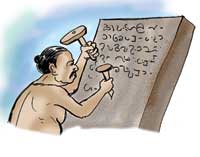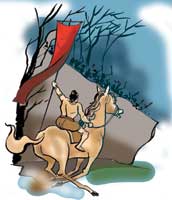
War in the Pandaya Kingdom~This article is part of a continuing series on the ‘Mahavamsa,’ the recorded chronicle of Sri Lankan history~ 1. The Burmese sources do not record the battle in the way the Sri Lankan records do. According to them, the invasion of Burma by the Sinhala army, was a minor one and that was done just as a punishment. King Alaunsitu, the Burmese king, did not die in battle. According to their records, he was still living, even when the Sinhala armies left their country. With the mediation of some Buddhist priests he had succeeded in coming to an agreement with King Parakramabahu.
2. After the signing of this treaty, trade continued between these two countries, as before. The exchange of envoys too continued as usual. However, according to our records, there had been a big celebration in Sri Lanka – after this war. At this function, the soldiers who bravely fought in the Burmese war were felicitated. They were honoured by conferring titles and awarding gifts. According to our chronicles, Commander Kitnuwaragal was highly recognized for his valuable service. 3. An inscription of King Parakramabahu too refers to this. It has been written in the 12th year of his rule. This is named the Devanagala inscription. Reference here confirms the fact that the Sinhala soldiers conquered the city of Bassen in Burma. It also refers to a team of envoys who were sent to Sri Lanka, to sign a peace treaty. 4. It is during this time, that King Parakramabahu had to go to war with another foreign power. It was against South India, in support of the Pandya country. By the beginning of the 10th century AD, the most powerful in South India was the Chola country. Though Chola power declined gradually, they had once again gained strength by this time. 5. For the Cholas, the neighbouring powers were Pandya, Kerala and Sri Lanka. All of them were not in favour of the rise of Chola power. The Cholas' adopted a hostile attitude and a policy of invasion, when it came to her neighbours. When King Parakramabahu was ruling in Sri Lanka, King Raja Raja II was the Chola ruler. He was a war-like king and wanted to annex the neighbouring countries. He ruled from 1150 – 1176 A.D.
6. Long before Parakramabahu came to the throne, in fact for 83 years before he ascended the throne, there was no Chola invasion of Sri Lanka. To be exact, after King Vijayabahu I, there were no invasions of Sri Lanka. This was due to the decline of Chola power. This situation enabled the neighbouring countries to rule in peace. But in 1169 A.D., there was trouble due to struggle for the throne of the Pandya Kingdom. 7. This fact was instigated by a prince named Kulasekera. The Pandya king at the time was a ruler named Parakrama Pandya. He had been maintaining a close relationship with Sri Lanka and he was a good friend of King Parakramabahu. All of a sudden, Prince Kulasekera had come with his army and besieged the city of Madura. When the capital was besieged the entire Pandya country was up in arms. The king and his army had to enter the fight. But the Pandya army was not very powerful. 8. King Parakrama Pandya, immediately dispatched an envoy to Sri Lanka asking for military help. rince Kulasekera got to know this and he sought the help of the Cholas. King Parakramabahu decided to help the Pandya king. He summoned his commanders and convened a meeting. |
|| Front
Page | News | Editorial | Columns | Sports | Plus | Financial
Times | International | Mirror | TV
Times | Funday
Times || |
| |
Reproduction of articles permitted when used without any alterations to contents and the source. |
© Copyright
2007 | Wijeya
Newspapers Ltd.Colombo. Sri Lanka. All Rights Reserved. |

